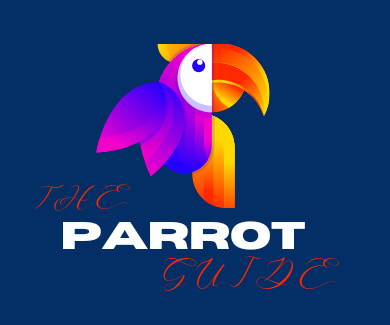Different Types of Macaws – A Comprehensive List With Photos
Macaws are colourful and attractive Parrots, and they have always attracted people. Different types of Macaws found in the Amazon jungle come in a variety of colours and many of them have very different characteristics and behaviour from each other.
In this particular article we know about these parrots and what makes them unique. Here we will try to understand what is special about Macaw parrots, such as their appearance and behaviour.
Then we look closely at each type of macaw such as Blue-Gold macaw, scarlet macaw etc, and find out where they live and why they are so loved as pets.
Macaws are not only beautiful, but they help lots by spreading seeds all over the jungle, it’s sad to see them losing their homes and being taken from the jungle to be sold out as pets.
So come and visit the unique and incredible world of the Macaw Parrot. We are discussing here the most popular types of macaws.
How many different types of macaw are there in the world?
There are many different types of macaw parrots in the world. As per Wikipedia records, there are around 19 different types of macaw parrot species available in the world. (17 Living + 2 Extinct). We recommend checking with a reliable source.
Contents
All different types of macaw species list (Living)
- Lear’s Macaw (Indigo macaw)
- Spix’s Macaw (Little blue macaw)
- Blue-throated Macaw
- Yellow-collared Macaw (Golden-collared Macaw)
- Golden-collared Macaw
- Chestnut-fronted Macaw (Severe macaw)
- Red-bellied Macaw
- Blue-headed Macaw (Coulon’s Macaw)
- Red shoulder Macaw (Hahn’s Macaw)
Popular different types of macaw species
- Blue-and-gold Macaw (Blue and yellow macaw)
- Scarlet Macaw
- Green winged macaw (Red-and-green Macaw)
- Hyacinth Macaw
- Military Macaw
- Red-fronted Macaw
- Buffon’s Macaw (Great green macaw)
- Glaucous Maca
Other types of macaw species (Extinct)
- Cuban macaw
- St. Croix macaw
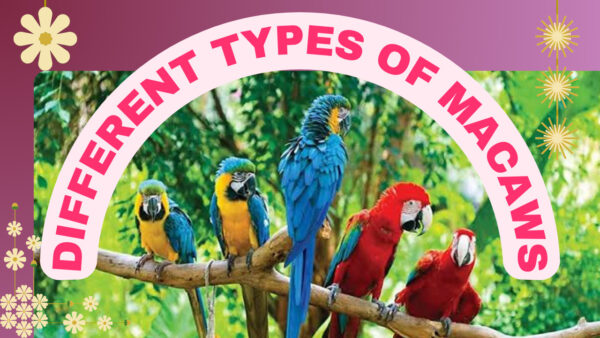
General Characteristic of Macaws species
| Colorful Plumage | Macaws are known for their vibrancy, they have colourful plumage, which makes them different from other parrots. |
| Long Tails | Macaws have long tails which help in maintaining balance while flying. |
| Large size | Macaws are larger parrots, most growing up to 3 feet long. |
| Strong Beaks | Their beak is curved and very strong, with which they can break and eat hard objects like nuts and seeds. |
| Intelligence | Macaws are highly intelligent, can learn human speech and mimic as well. |
| Social Nature | Macaws are social birds, and they can easily make close bonds with their caretakers. |
| Long Lifespan | With proper care, macaws can live for several decades, and some species can live up to around 80 years or even more. |
| Playful Behavior | Macaws have a very playful nature and they are always doing some entertaining things. |
Here is the summary of some popular different types parrots of macaw parrots below 👇
Blue and Gold Macaw
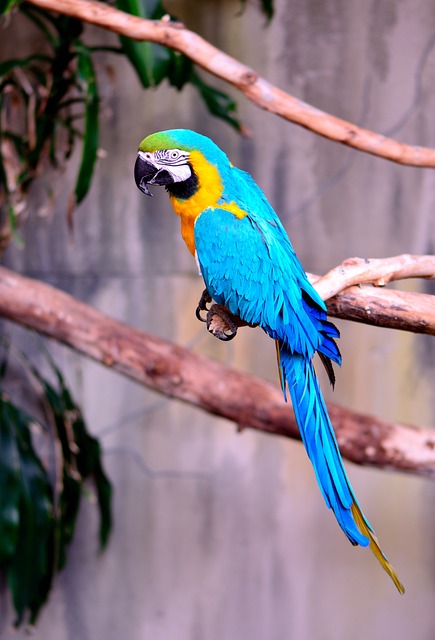
Appearance
As per the name, Blue and gold macaws have a brilliant blue colour on the upper body of wings and tail, while golden yellow feathers on the lower body of the chest and belly.
Feathers’ brilliant blue colour shines brightly in sunlight while plumage’s golden yellow colour provides a stunning contrast with the blue feathers.
Blue and gold macaws have long and pointed tails that provide them with support and balance while flying.
These macaws have a white patch around their eye surrounded by black feathers.
Blue and gold macaws have a strong curved black beak ideal for cracking nuts and seeds.
They have dark grey feet with strong claws ideal for control and climbing.
Diet
In the jungle, they can eat various fruits, nuts, seeds and vegetables.
While they are kept as pets, should be provided with a proper diet of foods like fruits, nuts, seeds, vegetables and pellets.
Behavior
Blue and gold macaws are very social birds and can interact with their owners and other birds.
They are very friendly in nature, make special bonds with their owners and like to spend quality time with them.
Intelligence
Blue and gold macaws are highly intelligent birds and can copy various sounds and mimic human speech as well.
Like many other parrots, they are very noisy especially when excited or seeking attention.
They are naturally playful, active and curious birds, and they are also emotionally sensitive.
While flying they cover long distances in search of food or nest sites.
Natural Habitat
Blue and gold macaws are native to the rainforest of South America especially in Brazil, Bolivia and Paraguay.
Size and Weight
Blue and gold macaws are very long in size, around 33 inches from the beak to the tip of the tail.
One Adult blue and gold macaw weighs between 2.5-3.5 pounds (1.1-1.6 kg).
Lifespan
In a forest life, blue and gold macaws can live up to 30-40 years, but with proper care and attention, they can live up to 50 years.
Scarlet Macaw
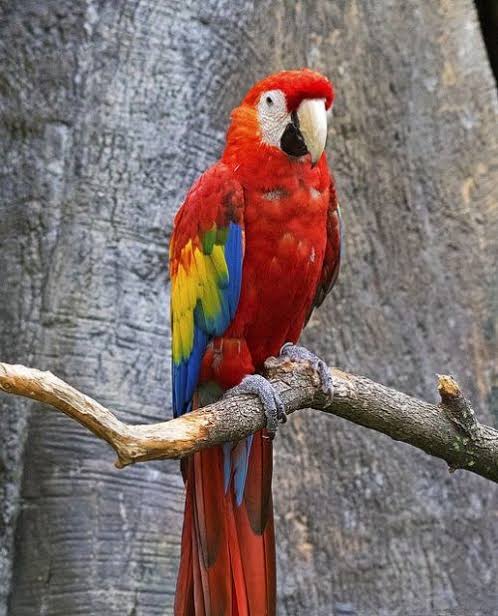
Appearance
The scarlet macaw’s feathers are bright red coloured and cover most of its body, including the wing and tail feathers.
While the yellow, blue and slightly blue feathers on its wings enhance its amazing beauty.
Scarlet macaws have a long and pointed tail providing them balance while flying. These macaws have white feathers around the eyes site.
Scarlet macaws have strong and curved white beaks suited for cracking nuts and seeds.
They have dark grey feet with strong claws ideal for grasping and climbing.
Diet
Scarlet macaws can eat various fruits, nuts, seeds and vegetables.
If they are kept as pets, then provided with a proper diet of foods like fruits, nuts, seeds, vegetables and pellets.
Behavior
Scarlet macaws are social birds they can interact with their caretakers and other birds, they can create strong bonds with their caretakers and spend quality time with them.
Intelligence
Scarlet macaws are talented birds and can copy some sounds and mimic them as well.
Like other parrots, they screech loudly to communicate with other parrots and express themselves.
They are naturally playful and curious birds and are also emotionally sensitive. Parrots often search for food and nesting sites while flying.
Natural Habitat
The scarlet macaw lives in the rainforests of the South American continent.
Size and Weight
Scarlet macaws are one the largest macaw species, around size 32 inches from beak to tip of the tail.
On average, adult Scarlet macaws weigh between 2.3-3.3 pounds (1-1.5 kilograms).
Lifespan
In wildlife, Scarlet macaws can live up to 40-50 years or above.
In captivity life with proper care and attention, they can live up to 60 years or more.
Green winged Macaw
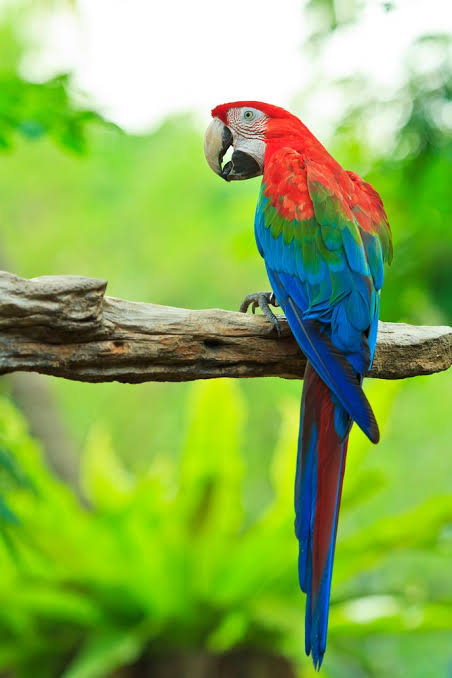
Appearance
Green-winged macaws have striking plumage and red colour on their head, a top body with vibrant green wings, deep blue and red tail feathers, giving them their name, and white patches around the eyes.
Green-winged macaws have strong black-white beaks suited for cracking nuts and seeds.
Diet
Green-winged macaws eat foods like berries, fruits, nuts, seeds, and vegetables.
If they are in captivity, they should be provided with foods like fruits, vegetables and parrot shells and a proper diet.
Nuts and seeds can be given occasionally to meet their high-fat requirements.
Behaviour
Green-winged macaws are also social birds. They always interact with their caretaker and other birds.
In the jungle, they are always flying in pairs or small groups.
Intelligence
Green-winged macaws are smart birds and can learn human speech and various sounds very well.
These birds are very emotionally and sensitive and can form bonds with their trainer.
Green-winged macaws know how to learn by observing others and solving puzzles too.
Natural Habitat
Green-winged macaws are mainly live in Central and South America.
They are mainly living in countries like Brazil, Paraguay and Bolivia.
Size and Weight
Green-winged macaws are one the larger macaw species, around size 34 inches from beak to tip of tail.
Green-winged macaws weigh 2.6-3.7 pounds (1.2-1.7 kilograms) When they become adult.
Lifespan
In forest life, green-winged macaws can live up to 60 years, but with proper care and attention, they can live up to 60-plus years.
Hyacinth Macaw
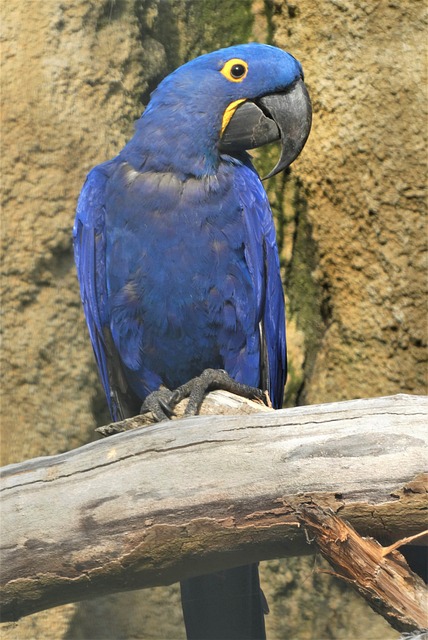
Appearance
Hyacinth Macaws are fully covered with vibrant cobalt blue feathers, which is the reason one of the most beautiful parrots in the world.
Hyacinth macaw has a bare patch of yellow skin around the eye site.
Hyacinth macaw has bright yellow patches under side its wing and appears only when hyacinth macaw is flying.
Hyacinth macaws have large strong curved black beaks suited for cracking nuts and seeds.
They have dark grey feet with strong claws ideal for grasping and climbing.
Diet
Hyacinth macaws eat various berries, fresh fruits, nuts, seeds and vegetables.
If they are kept as a pet then provide them with a proper diet of foods like fruits, vegetables, high-quality parrot pellets, palm nuts, seeds and fresh water.
Behavior
Hyacinth macaws are also social birds they can interact with their caretaker, they can create strong bonds with their caretakers, and changes in environment and routine should be careful with them.
Intelligence
Hyacinth macaws have a curious nature. they like problem-solving activities like puzzles.
When they fly they explore their entire region and cover long distances in search of food and nest sites.
Natural Habitat
Hyacinth macaws are native to parts of South America including countries like Brazil, and Bolivia, Mainly they live at inhabit tropical rainforests, palm swamps, and savannas.
Size and Weight
Hyacinth macaws are one the largest macaw species in the world, around size is 40 inches from beak to tip of tail.
On average, adult Scarlet macaws weigh between 2.6-3.7 pounds (1-2-1.7 kilogram).
Lifespan
In a forest life hyacinth macaws can live up to 30-40 years, but with proper care and attention, they can live up to 50 years.
Military Macaw
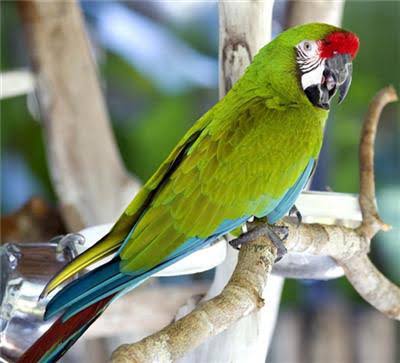
Appearance
Military macaws have a lemonade green plumage covering most of their body, bright red on the forehead, and blue and turquoise wing feathers.
It has a white facial patch around the eyes and a black beak.
They have dark grey feet with strong claws ideal for grasping and climbing.
Diet
Military macaws eat fruits, nuts, seeds and vegetables.
If they are kept as pets then should be provided Some common foods include apples, bananas, carrots, almonds, and sunflower seeds.
Behavior
Military macaws are social parrots and can interact with their pet owner and other birds.
They can create strong bonds with their pet owner and like to spend some quality time with them.
Loneliness is dangerous for them so provide them a partner or spend some time with them.
They are very protective and also dangerous to other birds for their space especially during breeding seasons.
Intelligence
Military macaws are intelligent birds, Military macaws can learn tricks and commands with proper training, and they are known for their playful and curious nature, some military macaws are capable of mimicking human speech and sounds but not other Parrot species.
Natural Habitat
Military macaws live in the tropical rainforest of Central and South America, including countries like eastern Mexico, western Colombia, Ecuador and northern Venezuela.
Size and Weight
Military macaws are medium to large-sized macaws, the average size is 26 to 32 inches from head to tail.
On average, an adult military macaw weighs between 2.0-2.9 pounds (0.9-1.3 kilogram).
Lifespan
Due to environmental challenges and predators, their lifespan is shorter than other different types of macaw, they can live up to 30-35 years, but they can live up to 60+ years as pets treated with proper care and attention.
Red fronted Macaw
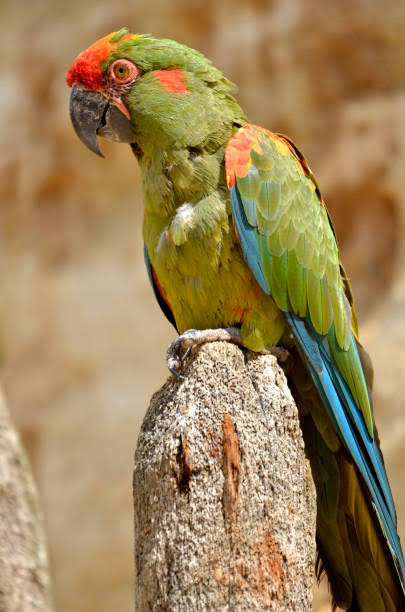
Appearance
The special features are its bright red forehead and the red colour extended to the eye area giving its name a red-fronted macaw.
Their body is mainly green, with shades from olive green to emerald green.
They have a little red on the front of the wings, blue at the bottom of the wings and a long tail with a mix of green, blue, and reddish feathers.
Red-fronted macaws have large, powerful curved black beaks suited for cracking nuts and seeds.
Diet
Red-fronted macaws eat similarly to other macaws, they eat some fruits, nuts, seeds and vegetables.
If they are kept as a pet, then provided Some common foods include apples, bananas, carrots, almonds, and sunflower seeds.
Behavior
Red-fronted macaws are social parrots, they can interact with their companions with head bobbing, preening, and vocalizations.
During the breeding seasons, they show nesting behaviour.
Red-fronted macaw has a Sunbathing behaviour, they spread their wings to absorb sunlight which is beneficial for their feathers and overall health.
Intelligence
Red-fronted macaws are intelligent birds, they can learn tricks with proper training, they are known for their playful and curious nature, and they explore their environment and play with toys.
Red-fronted macaws often use whistling to communicate with each other and express their feelings.
Natural Habitat
Red-fronted macaws are native to South America’s limited range.
Their main natural habitat areas are dry forests, thorny woodlands and palm groves, they are mostly found in the Beni area of northern Bolivia’s lowland and foothill regions.
Size and Weight
Red-fronted macaws are medium-sized birds, standing about 21 to 24 inches tall, and an adult red-fronted macaw weighs in at about 10 to 16 ounces (0.30–0.45 kg).
Lifespan
Red-fronted macaw’s lifespan is shorter than other types of macaw. They can live up to 30-35 years, but they can live up to 40+ years as pets.
Buffon’s Macaw
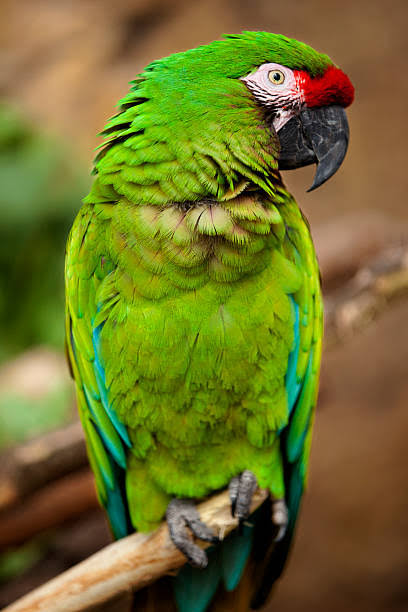
Appearance
Buffon’s macaw is also known as a great green macaw because it’s a green parrot.
They have a vibrant emerald green colour plumage covering most of their body, bright red on the forehead and crown area, while cheeks and throat blue and turquoise hue.
It has a white facial patch around the eyes and a black beak.
They have dk. grey feet with strong claws ideal for grasping and climbing.
Diet
Buffon’s macaw eats fruits like figs, palm fruits, other tropical fruits, seeds and vegetables. If they are kept as a pet then provide them with high-quality parrot pellets Some common foods include apples, bananas, carrots, almonds, and freshwater.
Behavior
Buffon macaws are highly social parrots, interacting with their owners as if they were family members. They communicate with them through calls, screams and sounds. They have protective behaviour regarding their nesting sites and feeding areas. Buffon macaws like to bathe to keep their feathers clean.
Intelligence
Buffon macaws are intelligent birds and can learn tricks, solve puzzles, etc. Being playful and inquisitive by nature, they like to explore their surrounding environment and also love playing with toys. They use different vocalizations to talk to each other such as calling and screaming
Natural Habitat
Buffon macaws are found in the humid lowlands and forests of Central and South America.
Size and Weight
Buffon’s macaw is one of the largest-sized macaws. Its average size is 33-36 inches from head to tail, and an adult Buffon’s macaw weighs between 2-2.6 pounds (0.90-1.2 kilogram).
Lifespan
Buffon’s macaws can live up to 30-50 years, but with proper care and attention, they can reach 60 years or more.
Glaucous Macaw
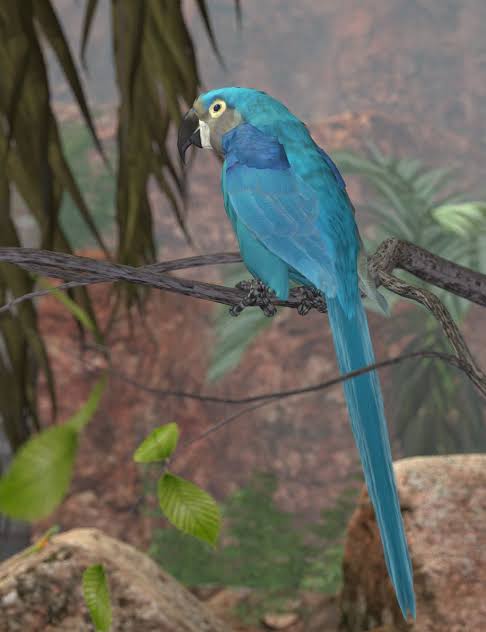
Appearance
Glaucous Macaws are fully covered with vibrant and bright blue feathers. The glaucous macaw has a noticeable bright-yellow bare patch around the eye site. The glaucous macaw has a large and powerful beak, which is black in colour with some greyish areas near the base. They have dark grey/black feet with strong claws that provide them with stability, support and move forward.
Diet
Glaucous macaw eats fruits, plant nuts, seeds and vegetables and also consume mineral-rich clay to neutralize toxins from their body. If they are kept as a pet then provide them with high-quality parrot pellets, apples, bananas, carrots, almonds and fresh water.
Behavior
Buffon’s macaws are social birds and live in flocks and communicate with calls, screeches and vocalizations.
Intelligence
Glaucous macaws are smart birds, they are known for their active nature, and they enjoy playing with toys.
Natural Habitat
Glaucous macaws live in South American countries like Brazil, Paraguay, and Argentina.
Size and Weight
Glaucous macaws are medium to large-sized macaws. The average size is 30 inches from the top of its head to the tip of its tail feathers, and an adult glaucous macaw weighs between 2 to 3.3 pounds (1.5 kilograms).
Lifespan
In the wildlife, the Glaucous macaw’s lifespan is unknown. In general, they can live up to decades, reaching 50-60+ years depending on their species.
FAQ
Where do Macaws live?
Macaws live in Central and South America, countries like Brazil, Peru, Bolivia, and Paraguay. Mainly live inhabiting tropical rainforests, palm swamps, and savannas.
How many types of Macaws are there?
Among the different types of macaws, the scarlet macaw, blue and yellow macaw, green-winged macaw, hyacinth macaw and military macaw are popular macaws.
What are Macaws?
Macaws are large, colourful parrots, They are known for their vibrant plumage, strong beaks, and long tails.
What do Macaws eat?
Macaws offen eat fruits, nuts, seeds and some vegetables. Some species also eat Berries and larvae as part of their diet.
Are Macaws endangered?
Yes, Macaw species are classified as endangered due to habitat loss, illegal pet trade, and other issues.
How long do macaw live?
Macaws live long lives in their natural habitat. On average, they can live from 30 to 50 years, but some well-cared-for macaws have been known to live up to 80 years.
Conclusion
Some common types of macaws include the Scarlet Macaw, Blue-and-yellow Macaw, Green-winged Macaw, and Hyacinth Macaw, many others. Each species has different colour patterns. We hope people like our article, if you have any kind of suggestions then write us in the comment box.
